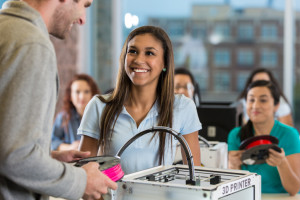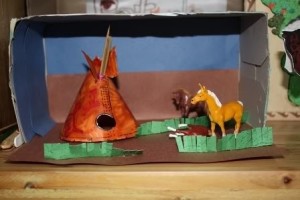
Amazing!
Or … is it?
Without wading into the thornier issue that the assignment was slyly related to a side business the teacher was running out of his basement (the focus of the Times piece), I had a question about the educational value of the project: What do we imagine students are thinking about when they engage in this sort of exercise?
Learning to use software and a 3-D printer to manipulate shapes and objects is a perfectly valid objective. But this was supposed to be an opportunity to think about themes from the novel. The student who chose the printer assignment probably didn’t put much thought about social justice into the task.
We know from cognitive studies of how our brains process information that we must at some point concentrate on what we’re learning to develop long-term memories. As University of Virginia cognitive psychologist Daniel Willingham states: “Students remember … what they think about.”

SHOEBOX DIORAMA
Yet all too often, we give kids assignments that focus their brains on something other than what we want them to learn. For example, consider this shoebox diorama: What was this student thinking about as he completed this assignment? Perhaps that his brown marker was running low? Or that he ran out of blue paper to finish the sky on the right side of the box? Or that his third horse kept falling over? Probably very little thought went to the nomadic culture or history of the Plains Indians (which seems to have been the focus of the assignment).
I actually remember doing an assignment like this as a kid in the 70s—valiantly attempting to capture the many splendored wonders of South Dakota in a shoebox, from Mount Rushmore to Dinosaur Park to the Corn Palace. Good stuff, to be sure. Yet seeing how that’s all I remember now, it’s probably all I thought about during that assignment. And I’m pretty sure South Dakota is a far more remarkable place than that.
So, the trouble here isn’t really with technology itself, given that we hardly need whiz-bang gadgets to create learning tasks that miss the mark. Yet technology in the classroom often adds a “wow” factor that can be seductive and distracting. Before trying to liven up an assignment with technology—before making any assignment, really—we need to step back a moment and ask ourselves, What are students really thinking about as they do this work? And is it the right stuff to be thinking about?
With this in mind, here are two quick questions you can ask to avoid the pitfall of creating “too cool for school” learning tasks that fail to direct students to thinking about what’s most important:
- What are the key concepts and big ideas I want students to recall years from now?
- Will this assignment focus student thinking on these concepts and big ideas?
Look, I appreciate any teacher who’s thinking creatively about how to make learning more engaging for students. That’s a noble impulse. Teachers ought to be creative in their classrooms. They ought to share new innovations and ways of helping students learn. Yet, let’s remember that the most important way to engage students is with their thinking. So, with every assignment, we ought to ask, Am I thinking about what I’m asking my students to think about?


Good Article…..This is too cool idea rather than so boring study.